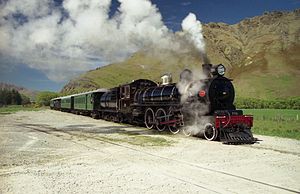NZR AB class

Preserved AB 778 hauling the Kingston Flyer
|
|||||||||||||||||||||||||||||||||||||||
|
|||||||||||||||||||||||||||||||||||||||
|
|||||||||||||||||||||||||||||||||||||||
|
|||||||||||||||||||||||||||||||||||||||
|
|||||||||||||||||||||||||||||||||||||||
| Type and origin | |
|---|---|
| Power type | Steam |
| Builder |
NZGR Addington Workshops (38) North British Locomotive Company (83) A & G Price Limited, Thames (20) |
| Build date | 1915–1918, 1921–1927 |
| Total produced | 141 |
| Specifications | |
|---|---|
| Configuration | 4-6-2 |
| Gauge | 3 ft 6 in (1,067 mm) |
| Driver dia. | 54 in (1.372 m) |
| Wheelbase | 52 ft 6 in (16.00 m) |
| Length | 62 ft 5 in (19.02 m) |
| Loco weight | 51.3 long tons (52.1 tonnes; 57.5 short tons) |
| Tender weight | 33.4 long tons (33.9 tonnes; 37.4 short tons) |
| Total weight | 84.7 long tons (86.1 tonnes; 94.9 short tons) |
| Fuel type | Coal |
| Fuel capacity | 4.0 long tons (4.1 tonnes; 4.5 short tons) |
| Water cap | 3,500 imp gal (16,000 l; 4,200 US gal) |
| Firebox: • Firegrate area |
33 sq ft (3.1 m2) |
| Boiler pressure | 180 lbf/in2 (1.24 MPa) |
| Heating surface | 1,148 sq ft (106.7 m2) |
| Superheater: |
|
| • Heating area | 204 sq ft (19.0 m2) |
| Cylinders | Two, outside |
| Cylinder size | 17 in × 26 in (432 mm × 660 mm) |
| Performance figures | |
|---|---|
| Maximum speed | 60 mph (97 km/h) |
| Tractive effort | 20,030 lbf (89.10 kN) |
| Career | |
|---|---|
| Operators | NZR |
| Numbers | 608–838 |
| Locale | All of New Zealand |
| First run | October 1915 |
| Withdrawn | 1963–1969 |
| Preserved | 7 (608, 663, 699, 745, 778, 795, 832) |
| Current owner | Kingston Flyer, Mainline Steam, Pleasant Point Museum and Railway, Museum of Transport and Technology, Ferrymead Railway, Rimutaka Incline Railway Heritage Trust. |
| Disposition | Seven preserved, two lost in the wreck of Great Barrier Island in 1922, remainder scrapped. |
The NZR AB class was a class of 4-6-2 Pacific tender steam locomotive that operated on New Zealand's national railway system. Originally an improvement on the 1906 A class, 141 were built between 1915 and 1927 by NZR's Addington Workshops, A & G Price Limited of Thames, New Zealand, and North British Locomotive Company, making the AB class the largest class of steam locomotives ever to run in New Zealand. An additional ten were rebuilt from the tank version of the AB – the WAB class – between 1947 and 1957. Two North British-made locomotives were lost in the wreck of the SS Wiltshire in May 1922.
The genesis of the AB class originated from the construction of A class 4-6-2 NO 409 at Addington Railway Workshops in 1906. A two-cylinder simple-expansion locomotive, 409 was initially classified AB to differentiate it from the four-cylinder compound A and AD class locomotives, which were by and large of a similar design although built as compounds. AB 409 was in reality the 'guinea pig' for what would become the most prolific type on the New Zealand Railways network, with construction beginning on a new prototype 4-6-2 in 1915.
The new locomotive, AB 608, was to a completely different design from AB 409 when it emerged from the Addington Workshops in 1915. Although largely similar to the A class, it had a new design of cab and boiler, which was fitted with a superheater after trials conducted on AB 409. It also had the distinctive Vanderbilt tender, which would become a hallmark of the AB class during its working life. This locomotive was to become the first of 141 similar locomotives built by various builders in New Zealand and the United Kingdom for NZGR.
The AB class compared more favourably in service against the compound A class. Reputedly the first engine able to generate one horsepower for every 100 pounds of weight (16.4 W/kg), the AB class was efficient and versatile, and the engines were easy to maintain and operate. However, it became clear that there were several shortcomings of the design – notably the cab was too small, and the tenders were not sturdy enough. A new and longer cab was fitted to all new locomotives being built from that time onwards, with the first appearing on AB 663. New tender structures were also built at a later date.
...
Wikipedia
